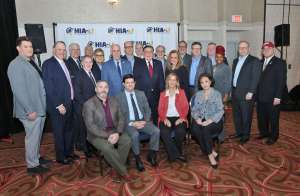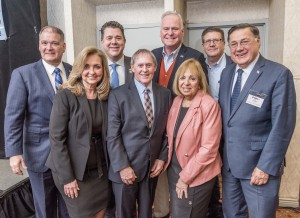
As the President and CEO of HIA-LI, I am proud that HIA-LI continues to serve as the steward and advocate for the Long Island Innovation Park at Hauppauge (LI-IPH).
One important recommendation that came out of the LI-IPH’s April 2019 Sustainability Study was that we should take a serious look at integrating workforce housing into the Park. It’s a concept in keeping with the “live-work-play” model that has worked so successfully in other Long Island communities such as Patchogue, Ronkonkoma, Farmingdale, and Bay Shore.
To that end, we teamed up with the Long Island Builders Institute (LIBI) and convened a March 28 meeting of residential developers to discuss opportunities in the Park. Joining me at the roundtable discussion was Michael Florio, LIBI’s CEO; Joe Campolo, Managing Partner at Campolo, Middleton & McCormick, LLP, an HIA-LI Board Member, and Chair of our Economic Development Task Force; Peter Hans, the Town of Smithtown Planning Director; and Cara Longworth, Vice President and Long Island Regional Director of Empire State Development.
Cara Longworth discussed the Long Island Investment Fund (LIIF), which focuses on large-scale, transformative projects that will have lasting impacts on the bi-county region. Eligibility for the fund was expanded last year to include infrastructure for transformative multi-family housing development projects to support regional industry growth.
She added that municipalities that achieve the State’s “Pro-Housing Communities” designation – because of their hard work to address the housing crisis – will receive priority in their applications for funding streams like LIIF.
Peter Hans spoke about zoning issues, specifically the town’s overlay district – approved in 2019 – which now permits residential development on certain parcels in the LI-IPH depending on size and location. Right now, Peter said there are 13 parcels eligible for mixed use/residential development.
The dialogue continued on April 16 when we welcomed a distinguished panel to discuss the immense opportunities at the LI-IPH. This event – titled “Why Do Business in the Largest Innovation Park in the Northeast” – was held at the Suffolk Y Jewish Community Center in Commack. It underscored our collective commitment to fostering economic growth and innovation at the LI-IPH.
The numbers are worth repeating: LI-IPH houses 1,350 companies who employ 55,000 workers and generate $13 billion in economic output. In short, one in 20 jobs on Long Island are dependent on the fiscal vitality of the LI-IPH. That’s impressive.
The morning began with inspiring opening remarks from Suffolk County Executive Ed Romaine; Town of Islip Supervisor Angie Carpenter; and Smithtown Councilman Tom Lohmann, the town board’s liaison to the LI-IPH. Their insights set the stage for a robust dialogue on the strategic advantages of doing business in the Park.
Moderated by Joe Campolo, the subsequent panel discussion featured key stakeholders including Kelly Murphy, Executive Director and CEO of the Suffolk County Industrial Development Agency (IDA); Mike Narula, CEO of Orbic, a firm new to LI-IPH that will be bringing a thousand new jobs from India; alongside Angie Carpenter and Tom Lohmann. Each panelist provided a unique perspective on the evolution and future of the LI-IPH.
Our panelists shared exciting developments within LI-IPH, including the sale of a $21 million vacant data center to Links Logistics, the transformation of a $5.3 million deal into a new headquarters for E+M Logistics, and a $44 million investment by Venture One Acquisition to create new industrial space. These investments not only demonstrate the economic vitality of LI-IPH but also highlight our adaptability and forward-thinking approach to growing our infrastructure and meeting the business needs of park tenants as well as the Long Island region.
Joe Campolo’s presentation focused on the transformation of LI-IPH from a traditional industrial park to a thriving innovation hub. He outlined the concept of an “Edge City,” which integrates business, entertainment, and living spaces, allowing for a dynamic community where individuals can live, work, and thrive without long commutes. This concept has turned LI-IPH into a model for modern economic development.
The Suffolk County IDA has been instrumental in supporting this transformation. Kelly Murphy noted that over the past six years, the IDA has facilitated significant investments that have led to job creation and retention, enhancing the economic fabric of Suffolk County.
Over the past three years alone, the Suffolk IDA has provided support to 21 projects in the LI-IPH, with a total private capital investment of more than $527 million, a total of nearly 5,000 jobs created or retained, with an annual payroll in excess of $350 million.
The Suffolk IDA’s efforts underscore the powerful impact of strategic governmental partnerships in regional economic development.
Council Lohmann spoke about a recent HIA-LI/Town of Smithtown partnership that saw the installation of over 400 sponsored flags throughout the LI-IPH, a visual representation of our pride and collective identity as a major economic engine. This branding effort – combined with new entryway signage thanks to the town – helps solidify the park’s presence in the community and beyond, reinforcing our role as a key player in Long Island’s economic landscape.
Conclusion: A Bright Future Ahead
As we look to the future, LI-IPH continues to be a beacon of innovation and economic prowess. Our ongoing initiatives, such as the development of workforce housing and infrastructure improvements, are poised to enhance our competitiveness and attractiveness to businesses and professionals alike. The discussions held during these two events are a testament to the collaborative spirit that drives our success.
We are grateful to all attendees, panelists, and partners who contributed to this enriching discussion. Together, we are setting the stage for continued prosperity and improvement at the Long Island Innovation Park at Hauppauge.
For more information about the Long Island Innovation Park at Hauppauge, go to www.li-iph.org. For information about HIA-LI and our initiatives, please visit www.hia-li.org. Let’s continue to innovate and grow together, building a thriving economic future for Long Island.








